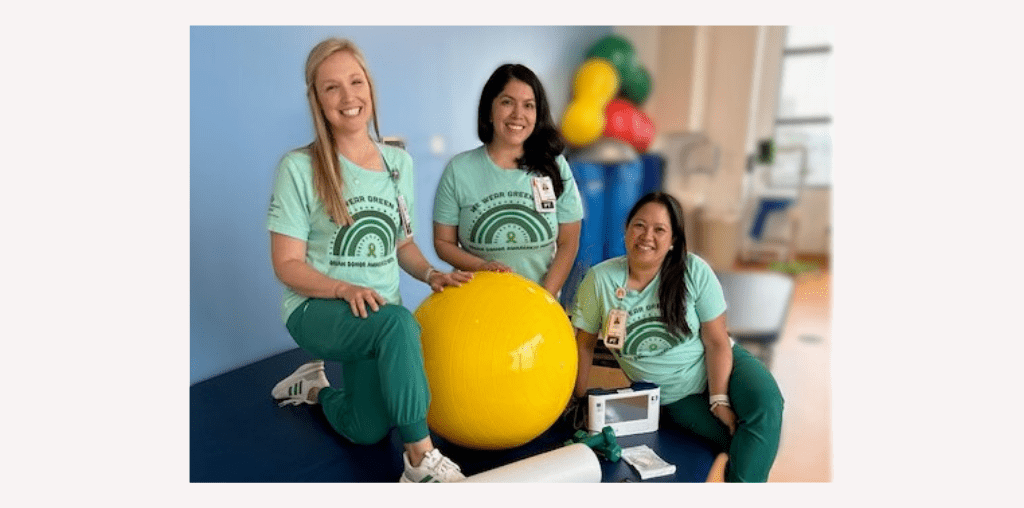How Physical Therapists Help Texas Children’s Transplant Patients Reclaim Their Lives
Pediatric transplant physical therapy plays a critical role in the care of young transplant recipients at Texas Children’s Hospital. Physical therapists (PTs) are essential members of the multidisciplinary transplant team, guiding young patients through some of the most physically and emotionally demanding experiences of their lives. With expertise, creativity and compassion, they help children and teens build strength, regain mobility and work toward a return to daily life and play.
While many people may think of surgeons or physicians when they hear “transplant,” the role of PTs is also critical. At our Transplant Center, one of the largest and most respected pediatric transplant programs in the country, physical therapists work closely with patients receiving heart, lung, kidney and liver transplants. These highly specialized professionals support each child through a tailored plan of care, helping them improve lung capacity, endurance, balance and strength.
“I work with transplant patients daily,” says physical therapist Diana Trejo. “My role is to help them build strength and endurance before their procedure and support them throughout the post-transplant rehabilitation process to promote recovery and improve overall outcomes.”
Lung Transplant Rehabilitation Requires Deep Commitment
Since its inception in 2002, the Lung Transplant Program at Texas Children’s Hospital has become the nation’s leader, performing more than 30% of the pediatric lung transplants in the U.S. in the past 5 years. For our PTs who specialize in lung transplant, the relationship with each patient is especially deep and enduring. Brittni Willis, who has worked at Texas Children’s for nearly seven years, often sees the same patients in our pulmonary outpatient program multiple times a week, for months or even years.
“We work with our patients for a full hour every visit. We are asking them to do things that are very hard for them to do during our sessions, so our superpower is how well we get to know them,” Brittni shares.
This frequency and intensity of care creates bonds that are deeply personal and often life-changing—for both patient and provider. Kate Quiray, who also specializes in lung transplant rehabilitation, recalls a young patient she supported for more than two years.
“The family had relocated to Houston from outside the continental U.S. for a lung transplant. Post-transplant, the patient had to adjust to a new city, start middle school and re-learn how to run, jump and dance. Our sessions were about physical rehab, but also included many conversations and emotional support,” Kate says. “Two years later, they invited me to their school musical. I cried watching my patient on stage knowing how hard they worked to get there.”

Adapting Care for Every Pediatric Transplant Patient
Treating pediatric transplant patients requires flexibility and attentiveness. PTs adapt sessions to fit the patient’s energy level, medication side effects, or emotional state. Safety protocols, such as contact precautions, are always top of mind. Kate explains, “Treating this population is unique because I have to consider more things than my other patients—where I treat them, how their medications are affecting them, how tired they are from appointments, and mental or emotional challenges.”
Diana shares what early sessions can look like: “When I first meet many of my patients on their transplant journey, they often require oxygen support even for the simplest daily activities. Some struggle to walk from the lobby to our treatment area, and we have to gradually build their strength to complete a full session—learning how to breathe properly and re-learn activities they once did with ease,” she says. “It’s a lot for them to manage, but they do it because they must. And at the end of the day, they’re still kids—they want to play, see their friends and live life like any other child. Seeing them navigate these challenges at such a young age is truly humbling.”
Creative Pediatric PT Keeps Kids Engaged
Despite the challenges, the team finds innovative and joyful ways to keep therapy engaging. That might look like a Kirby-themed board game where exercise cards help kids advance spaces, a rewarding round of Pictionary between activities, a mini golf course in the clinic hallway, or a playlist-fueled dance session.
“A fun dance session also doubles as a great workout and adds a bit of joy to the process—especially when Taylor Swift is involved!” Diana says with a smile.
This creativity is an essential tool to motivate children who may be overwhelmed by what they’re facing. “These kids are truly incredible! I am constantly in awe of their strength, resilience, and the way their families navigate their journey alongside them,” Diana says.
That sentiment is echoed by Brittni: “All of my patients are brave and resilient fighters for their lives. These kiddos are amazing, and it is an honor and privilege to get to know them and help them reach their goals.”
Commitment Through Challenges and Loss
The work is emotional. Unfortunately, some patients don’t survive despite the best efforts of everyone. But even through loss, the PTs remain committed.
“Honestly, there are times I’m having a hard day,” Brittni says. “But I think about the patients we’ve unfortunately lost, and I know they would want me to continue to learn as much as I can to help future children.”
Collaborative Care in a Supportive Environment
The team’s resilience is powered not just by the kids they treat, but by one another. PTs at Texas Children’s don’t work in isolation—they collaborate closely with colleagues across departments and are well supported by the transplant team.
“Whether it’s adapting treatment sessions or navigating complex social dynamics, I’m constantly refining my problem-solving skills to provide the best possible care,” Diana says. “The great thing about this role is I’m not doing it alone.”
Kate puts it best: “Being able to witness the resiliency, bravery, vulnerability, and the gift that a second chance at life brings is what drives my passion for this role. These kids have changed me in the best way.”
Be the Difference.
At Texas Children’s, our transplant physical therapists are vital partners in a child’s healing journey. If you’re inspired by meaningful work, specialized care, and the chance to change lives, explore our current opportunities and join our team.
Because at Texas Children’s, we don’t just treat patients—we walk alongside them, every step of the way.




